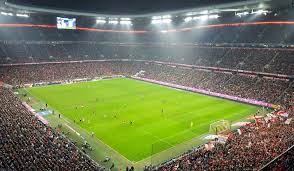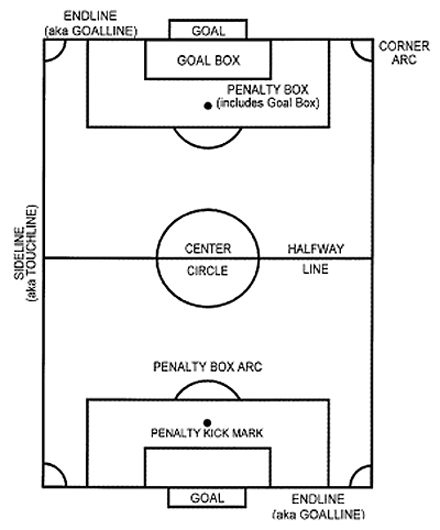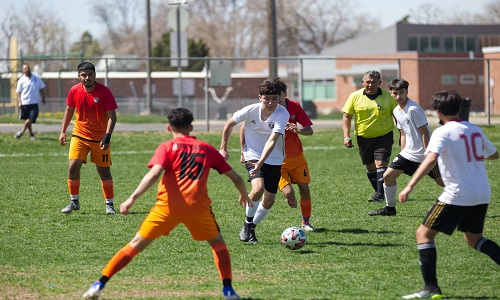Are you a soccer beginner? Before diving into this sport, you should at least know “what are soccer field dimensions?“.
There are many laws of the game and regulations to design an international soccer field. There are many components in the area that the player and audience cannot ignore.
Langley Rams will provide you with the latest updates on professional football field dimensions. Let’s dive in!
Contents
How long is a soccer field?
According to FIFA regulations, the dimensions of a soccer field are 120 yards in length and 80 yards in width. For minimum, this size can be 110 yards long and 70 yards wide.
There’s a lot of flexibility around that range. However, the best football field should be 120 x 75 yards.

The soccer field must be rectangular.
Soccer pitch dimensions:
In professional competition, people will specify the pitch size according to their standards. So, how long is a soccer field? Or, how big is a soccer field?
Related: Top 10 best soccer players of all time?
Previously, the minimum and maximum length had to be between 100 meters and 110 meters. The minimum and maximum width are from 64 meters to 75 meters.
Until 2008, the governing body of IFAB decided to change the size of the playing field according to the size standard:
- Court length: 105 meters (115 yards).
- Courtyard width: 68 meters (74yards).
With this standard length and width, the players can participate in a better way. They will quickly move, exercise more fit during the competition on the field.

Soccer pitch dimension
Youth Soccer Field Dimensions
Youth football field dimensions can be more diverse. At this time, the soccer field sizes will depend on the age and fitness of the players. Playing on a professional soccer field is not suitable for players from 6 to 14 years old.
View more: Soccer ball size by age
Commonly, the standard soccer field size for youth is from 15 x 30 yards to 60 x 100 yards. Players of this age usually prefer to play at the school football field or the youth soccer field.
In addition, the soccer field dimension also depends on the player’s fitness. For example, a young player’s stride is only half that of an adult player. So they will find joy playing in smaller yards.
If we intentionally let them play in the official soccer fields, they will quickly get bored and give up. Here is the youth soccer field table for your reference:
| Age | Youth Soccer Field Size
(Yards) |
| 14+ | 60 x 100 |
| 12 | 50 x 80 |
| 10 | 40 x 70 |
| 8 | 25 x 50 |
| 6 | 15 x 30 |
Chart of youth football field dimensions (Yards)
High School Football Field Dimensions
The high school soccer field is usually smaller than professional football fields. Usually, it is the football field for U14.
The NFHS has set the rules for high school soccer field dimensions as follows:
- Width: 55 -80 yards.
- Length: 110 -120 yards.
A large high school will set up its standard soccer field following its regulations and students.
Soccer Field Markings
Soccer field markings are the boundaries/white lines on the field. They have the task to help players, as well as referees on the field, can identify separate areas.
Soccer field lines must be uniform in width, usually no more than 12 cm. The specified paint color is white paint.
- Touch line: the line that defines the boundary of the field. It runs the length of the yard on either side.
- Endline: the lines that define the width of the field, located at the end of the area.
- Halfway line: the road helps to divide the area on the field into two regions with equal areas. This line will be right in the middle of the field.
- Center circle: this circle has a radius of 9.15 meters. Seen from above, you will quickly recognize this circle.
- Goal line.
The Layout of Soccer Field
There are a few areas on the soccer field layout that you need to remember as follows:
Goal Box
The goal area will start from a defined position and be 5.5 meters away from the goalposts. From there, we will draw two parallel lines extending into the goal area. These two lines are perpendicular to the endline.
Penalty Box
FIFA also regulates penalty box standards. Those are two parallel lines from the goal post with a length of 16.5 meters. They will also be perpendicular to the endline.
The whole part surrounded by these lines is the penalty area. It is also known as the area of 16.5 meters.
Penalty Spot
The penalty arc or penalty spot has the outside location of the penalty box. The penalty spot has a radius of 10 yards. Why this penalty spot?
When a player takes a penalty kick, all other players must stand a certain distance away from him. This half-circle will mark that distance.
Penalty Mark
In every model of the football field, there will always be a design called a penalty mark. For heavy fouls in the penalty area, the players will take penalty kicks on the penalty mark.
This mark is usually 22 cm in diameter.
Corner Arc
The corner arc will be the place where the players place the ball to take the corner kick. This position is “determined” by relying on the corner flagpole. The flag point is the center.
You draw the quarter circle into the area of the field. This quarter circle position is the corner arc.
Corner Flag
The corner flag area will be at the four corners of the field. The standard flag cannot be more than 5 feet tall. Usually, this is also the position to determine the corner arc in football matches.

Field of play soccer
Frequently Asked Questions
Here are some frequent questions about this topic:
1. What are international soccer goal dimensions?
For 11-a-side ball international matches, FIFA regulates the goal size as 7.32m x 2.44m x 1.5m (width x height x depth). The width of the goal posts and crossbars should not exceed 12 cm.
The football goal net must be “hooked” to the goal posts, edge of the crossbar, and firmly attached to the ground. The tension of the net must be appropriate to avoid hindering the goalkeeper’s ball-catching. However, the pressure must also be moderate to prevent the ball from bouncing back onto the court.
Goalkeeper nets are usually “made” of suitable materials such as fabric, jute, or nylon. The goal post and crossbar of the 11-man football goal are also in white.
2. Should we use natural grass or artificial turf for the playing surface?
People usually use one of two types of grass: natural or artificial. At international stadiums, people often use natural grass. Some other training stadiums for amateurs will use artificial turf to save costs.
Final Thoughts
In general, the above is the basic information about soccer field dimensions that readers should not ignore. The size may vary depending on the region and conditions. However, people are still aiming for such standards.
Langley Rams updates the latest global sports knowledge every day. If you are a fan of sports, please join us. Thank you for reading!






